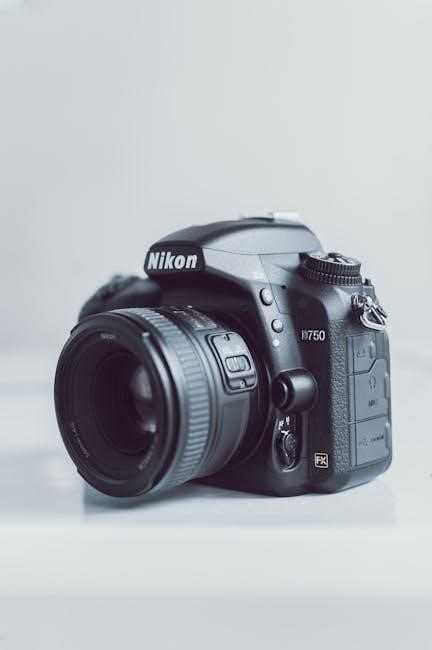
nikon d5500 manual
Nikon D5500 Manual: A Comprehensive Guide
Welcome to the ultimate resource for mastering your Nikon D5500! This comprehensive guide offers everything needed to unleash the camera’s full potential. From basic setup to advanced techniques, explore every feature and setting. Discover how to capture stunning photos and videos.
The Nikon D5500 is a versatile digital SLR camera designed for both beginners and experienced photographers. Released as a successor to the D5300, it boasts improved features and enhanced usability. The D5500 is known for its lightweight design, making it ideal for travel and everyday use. Its vari-angle touchscreen LCD allows for creative shooting from various perspectives, simplifying composing shots from high or low angles.
Equipped with a 24.2-megapixel sensor, the D5500 delivers high-resolution images with exceptional detail and clarity. The absence of an optical low-pass filter further enhances sharpness. The camera’s ISO range extends up to 25600, enabling excellent low-light performance. The D5500 also features a fast and accurate autofocus system, ensuring sharp and precise images.

Beyond still photography, the D5500 excels in video recording, offering Full HD 1080p video at various frame rates. The built-in microphone captures high-quality audio, and external microphones can be connected for improved sound. With its user-friendly interface and comprehensive features, the Nikon D5500 is a capable tool for capturing memorable moments.
Nikon D5500: Key Features and Specifications
The Nikon D5500 boasts a range of impressive features tailored to enhance the photography experience. At its core is a 24.2MP DX-format CMOS sensor, ensuring high-resolution images with exceptional detail. The absence of an optical low-pass filter contributes to sharper images. The camera’s ISO sensitivity ranges from 100 to 25600, providing excellent low-light performance.
The D5500 features a 39-point autofocus system, enabling fast and accurate focusing. Its 5 fps continuous shooting allows capturing action sequences with ease. The vari-angle 3.2-inch touchscreen LCD offers intuitive control and flexible composition. Full HD 1080p video recording at 60 fps delivers smooth and detailed videos. Built-in Wi-Fi allows easy sharing of photos and videos to smartphones and tablets.
Other notable specifications include a pentamirror viewfinder with approximately 95% coverage, a built-in flash with a guide number of 12, and compatibility with Nikon’s extensive range of F-mount lenses. The camera supports SD, SDHC, and SDXC memory cards. Its lightweight and compact design makes it ideal for travel and everyday use. The Nikon D5500 combines performance, versatility, and user-friendly operation.
Understanding the Nikon D5500 Controls and Buttons
The Nikon D5500’s external controls are designed for intuitive operation, allowing photographers to quickly adjust settings. On the top panel, the mode dial offers access to various shooting modes, including Auto, Program, Aperture Priority, Shutter Priority, and Manual. The command dial, located near the shutter button, adjusts aperture and shutter speed depending on the mode.
The shutter button, used to capture images, is surrounded by the power switch. The exposure compensation button allows quick adjustments to brightness. On the rear of the camera, the multi-selector navigates menus and settings. The “i” button provides access to quick settings, such as ISO, white balance, and picture control.
The menu button opens the main menu, while the playback button reviews captured images and videos. The delete button removes unwanted files. The display button toggles information displayed on the LCD screen. The AE-L/AF-L button locks exposure and focus. The function button (Fn) can be customized to access frequently used settings. Understanding these controls enhances efficiency and allows photographers to focus on capturing the perfect shot. Familiarizing yourself with each button’s function is essential for mastering the Nikon D5500.
Navigating the Menu System
The Nikon D5500’s menu system is organized into several sections, each containing related settings. Access the menu by pressing the “Menu” button on the camera’s rear. The “Playback Menu” allows you to review and manage your photos and videos. Options include deleting images, creating slideshows, and adjusting playback settings. The “Shooting Menu” provides control over image quality, size, white balance, ISO, and other shooting parameters.
The “Setup Menu” contains settings related to the camera’s overall operation, such as language, time zone, and LCD brightness. You can also find options for firmware updates and customizing button functions. The “Retouch Menu” offers in-camera editing tools, allowing you to apply filters, adjust brightness, and perform other enhancements.
The “Recent Settings” menu provides quick access to frequently used options. Navigating the menu system is straightforward using the multi-selector. Press the up and down arrows to move between menu items, and the left and right arrows to adjust settings. Understanding the menu structure is essential for customizing your camera and optimizing your shooting experience. Regularly exploring the menus will reveal hidden features and enhance your photographic control.
Shooting Modes Explained
The Nikon D5500 offers a variety of shooting modes, each designed for different scenarios and levels of user control. “Auto” mode is fully automatic, letting the camera handle all settings. “Scene” mode offers pre-set options for specific situations like portrait, landscape, and sports. “Effects” mode provides creative filters for unique looks.
“Program” mode allows the camera to set aperture and shutter speed, while you control other settings. “Shutter Priority” mode lets you select the shutter speed, with the camera adjusting the aperture. “Aperture Priority” mode allows you to choose the aperture, with the camera setting the shutter speed. “Manual” mode gives you full control over both aperture and shutter speed.
“Movie” mode is for recording videos, with options for different resolutions and frame rates. Understanding these modes is key to capturing the perfect shot. Experiment with each mode to learn how they affect your images. “Auto” is great for beginners, while “Manual” offers the most creative freedom. Choosing the right mode ensures optimal results in any shooting situation, unlocking the D5500’s potential.
Focusing Options and Techniques
Mastering the Nikon D5500’s focusing system is crucial for sharp, clear images. The camera offers several focus modes, including “Single-servo AF (AF-S)” for stationary subjects and “Continuous-servo AF (AF-C)” for moving subjects. “Auto-servo AF (AF-A)” automatically switches between AF-S and AF-C depending on subject movement. “Manual Focus (MF)” allows for precise focusing by hand.
The D5500 also provides different focus area modes. “Single-point AF” lets you select a specific focus point, ideal for stationary subjects. “Dynamic-area AF” uses multiple focus points to track moving subjects. “Auto-area AF” allows the camera to choose the focus points automatically. “3D-tracking AF” locks onto a subject and tracks its movement across the frame.
For sharp focus, use the appropriate focus mode and area mode for your subject. In AF-S mode, half-press the shutter button to focus, then fully press to take the picture. In AF-C mode, the camera continuously focuses as long as the shutter button is half-pressed. Experiment with different focus settings to find what works best for your shooting style and subject matter, ensuring consistently sharp and well-focused photos.
Exposure Settings: Aperture, Shutter Speed, and ISO
Understanding aperture, shutter speed, and ISO is fundamental to controlling exposure on your Nikon D5500. Aperture, measured in f-stops (e.g., f/2.8, f/8), controls the lens opening, affecting both the amount of light entering the camera and the depth of field. A wider aperture (smaller f-number) creates a shallow depth of field, ideal for portraits with blurred backgrounds. A narrower aperture (larger f-number) increases the depth of field, perfect for landscapes.
Shutter speed determines how long the camera’s sensor is exposed to light, measured in seconds or fractions of a second (e.g., 1/200s, 2s). Fast shutter speeds freeze motion, while slow shutter speeds can create motion blur. ISO measures the sensitivity of the camera’s sensor to light; Lower ISO settings (e;g., ISO 100) produce cleaner images but require more light. Higher ISO settings (e.g., ISO 3200) are useful in low-light conditions but can introduce noise.
Experiment with different combinations of aperture, shutter speed, and ISO to achieve the desired exposure and creative effects. Use aperture priority mode (A or Av) to control depth of field, shutter priority mode (S or Tv) to control motion blur, or manual mode (M) for full control over both aperture and shutter speed.
Using Built-in Flash and External Flash Options
The Nikon D5500 features a built-in flash, useful for adding light in dimly lit situations. To use it, press the flash button on the side of the camera. The flash can be used in various modes, including fill-flash, red-eye reduction, and slow sync. Fill-flash adds a touch of light to brighten shadows, while red-eye reduction minimizes the appearance of red eyes in portraits.
For more control and power, consider using an external flash. External flashes offer greater flexibility in terms of positioning and output. They can be mounted on the camera’s hot shoe or triggered remotely for off-camera lighting. External flashes also have faster recycle times and more advanced features like TTL (Through-The-Lens) metering, which automatically adjusts flash power for proper exposure.
When using flash, be mindful of its effect on the scene. Direct flash can create harsh shadows and unflattering highlights. To soften the light, use a diffuser or bounce the flash off a nearby surface. Experiment to discover how you can use flash creatively to enhance your photos.

Understanding Image Quality Settings
The Nikon D5500 offers a range of image quality settings that affect the size and appearance of your photos. These settings determine the resolution and compression of the image, impacting detail and file size. Higher quality settings result in larger files with more detail, ideal for printing or extensive editing. Lower quality settings create smaller files, suitable for sharing online or saving storage space.
The camera supports both JPEG and RAW formats. JPEG is a compressed format that balances image quality and file size. RAW files, on the other hand, are uncompressed and retain all the data captured by the sensor. This allows for greater flexibility in post-processing, as you can adjust exposure, white balance, and other settings without degrading image quality.
When choosing image quality settings, consider your intended use. For casual snapshots, JPEG may suffice. But for serious photography, RAW is recommended. Experiment with different settings to find the optimal balance between quality and file size for your needs. Understanding these settings will help you get the most out of your D5500.
Video Recording with the Nikon D5500
The Nikon D5500 is a capable video camera, offering Full HD 1080p recording at various frame rates. To start, select video mode using the mode dial. Then, use the live view button to see your composition on the LCD screen. Adjust settings like aperture, shutter speed, and ISO to control exposure and depth of field.
The camera offers both manual and automatic exposure control in video mode. Manual mode gives you complete creative control, while automatic mode simplifies the process by adjusting settings automatically. You can also adjust the microphone sensitivity to control audio levels.
The D5500 records video in MOV format using H.264 compression. It supports frame rates of 60p, 50p, 30p, 25p, and 24p. Higher frame rates like 60p are ideal for capturing smooth, slow-motion footage. Consider external microphones for improved audio quality. The D5500 provides a versatile platform for creating high-quality videos. Experiment with settings to achieve your desired look.
Troubleshooting Common Issues
Encountering issues with your Nikon D5500? Let’s address some common problems. If the camera won’t turn on, ensure the battery is charged and properly inserted. A frozen screen often resolves with a battery reset. Remove and reinsert the battery.
If images are blurry, check your focus settings and ensure sufficient lighting. Adjust ISO for low-light conditions. Error messages usually indicate specific problems. Consult your manual for clarification.
For autofocus problems, try switching to manual focus or cleaning the lens contacts. If the flash isn’t firing, check flash settings and ensure it’s enabled. Overexposed or underexposed photos can be fixed by adjusting aperture, shutter speed, or ISO.
If video recording stops unexpectedly, confirm your SD card has enough space and is compatible. Regularly update your camera’s firmware to resolve bugs and improve performance. Always refer to the official Nikon support resources for detailed guidance on specific issues. These tips will help keep your D5500 running smoothly.
Downloading and Using the Nikon Manual Viewer 2 App
Enhance your Nikon D5500 experience with the Nikon Manual Viewer 2 app! This handy application provides easy access to your camera’s manual right on your smartphone or tablet. Available for free on both the App Store and Google Play, it’s a must-have for all D5500 users.
To get started, simply download and install the app. Once installed, browse the available manuals and select the one for the Nikon D5500. The app offers a user-friendly interface, making it simple to search for specific topics or browse through the entire manual.
With the Nikon Manual Viewer 2, you can quickly find answers to your questions, learn new techniques, and troubleshoot any issues you might encounter. Enjoy the convenience of having a comprehensive guide at your fingertips, ensuring you never miss a shot. Stay informed and make the most of your Nikon D5500 with this invaluable app. Explore its features and elevate your photography skills today!

